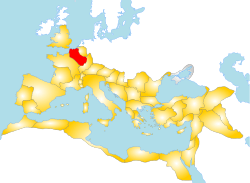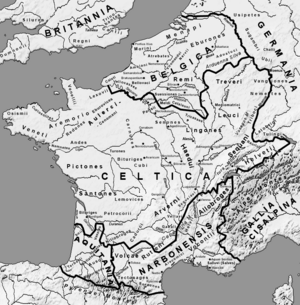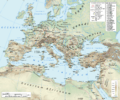Gallia Belgica facts for kids
Gallia Belgica, which means "Belgian Gaul" in Latin, was a Roman province. Different parts of it are in several countries today, including Belgium, Luxembourg, a big part of northern France, and part of the Rhineland in Germany, which is the part of Germany west of the Rhine River.
The people who lived in Gallia Belgica were called the Belgae. They were a group of tribes within the bigger country called Gaul, which covered all of modern France. According to Julius Caesar, the Belgae were different from the other Gauls. He said that the border between Belgica and the main Celtic part of Gaul was the Marne and the Seine rivers and that the border with Germania was the Rhine river. It is no longer certain what language or languages were spoken in Gallia Belgica, but historians know there was an influence of both Celtic and Germanic languages.
The area was conquered in 57 BC by Julius Caesar. Emperor Diocletian changed the Gaulish provinces around 300 AD. He split Belgica into two provinces: Belgica Prima and Belgica Secunda. Belgica Prima had Treveri (Trier) as its main city and was the eastern part. The border between Belgica Prima and Belgica Secunda was along the River Meuse.
In 406 AD, the Vandals, Burgundians and other tribes crossed the Rhine. They defeated the Gaulish forces. Belgica Secunda became in the 5th century the center of Clovis' Merovingian kingdom and during the 8th century the heart of the Carolingian Empire.
Images for kids
-
The Roman empire in the time of Hadrian (ruled 117-138 AD), showing, in northeastern Gaul, the imperial province of Gallia Belgica (Belgium/Picardie/Champagne)
-
The Porta Nigra of Trier, capital of Gallia Belgica, constructed between 186 and 200 AD
-
Representation of the Low Countries as Leo Belgicus by Claes Janszoon Visscher, 1611
-
'Belgica Foederata' was the Latin name of the Dutch Republic.
See also
 In Spanish: Galia Bélgica para niños
In Spanish: Galia Bélgica para niños










